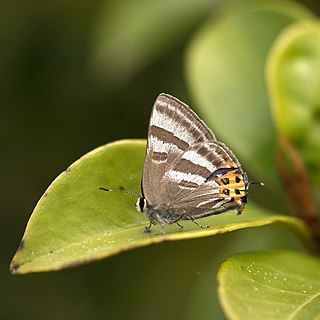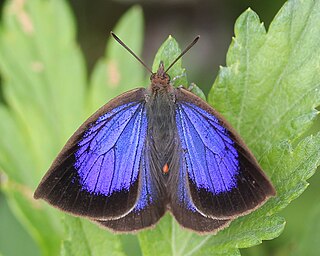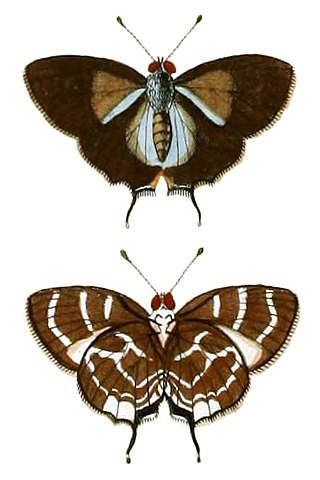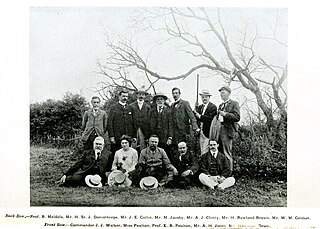
Lycaenidae is the second-largest family of butterflies, with over 6,000 species worldwide, whose members are also called gossamer-winged butterflies. They constitute about 30% of the known butterfly species.

Riodinidae is the family of metalmark butterflies. The common name "metalmarks" refers to the small, metallic-looking spots commonly found on their wings. The 1,532 species are placed in 146 genera. Although mostly Neotropical in distribution, the family is also represented both in the Nearctic, Palearctic, Australasian (Dicallaneura), Afrotropic, and Indomalayan realms.

Miletinae is a subfamily of the family Lycaenidae of butterflies, commonly called harvesters and woolly legs, and virtually unique among butterflies in having predatory larvae. Miletinae are entirely aphytophagous. The ecology of the Miletinae is little understood, but adults and larvae live in association with ants, and most known species feed on Hemiptera, though some, like Liphyra, feed on the ants themselves. The butterflies, ants, and hemipterans, in some cases, seem to have complex symbiotic relationships benefiting all.

Allotinus is a genus of butterflies in the family Lycaenidae. The genus was erected by Cajetan Felder and Rudolf Felder in 1865. The members (species) of this genus are found in the Indomalayan realm.
The Lex Oppia was a law established in ancient Rome in 215 BC, at the height of the Second Punic War during the days of national catastrophe after the Battle of Cannae, and repealed in 195 BC.

The Deudorigini are a tribe of butterflies in the family Lycaenidae.

Arhopala is a very large genus of gossamer-winged butterflies (Lycaenidae). They are the type genus of the tribe Arhopalini. In the relatively wide circumscription used here, it contains over 200 species collectively known as oakblues. They occur from Japan throughout temperate to tropical Asia south and east of the Himalayas to Australia and the Solomon Islands of Melanesia. Like many of their relatives, their caterpillars are attended and protected by ants (myrmecophily). Sexual dichromatism is often prominent in adult oakblues.

George Thomas Bethune-Baker was an English entomologist who specialised in Lepidoptera, especially those in the family Lycaenidae of butterflies.

32532 Thereus, provisional designation: 2001 PT13, is a centaur from the outer Solar System, approximately 80 kilometers (50 miles) in diameter. It was discovered on 9 August 2001, by astronomers of the Near-Earth Asteroid Tracking program at the Palomar Observatory in California, United States. This minor planet was named for the phrase thēreios bia 'beastly strength', used to describe centaurs in Greek mythology.

Thereus is a genus of gossamer-winged butterflies. Among these, it belongs belong to the tribe Eumaeini of the subfamily Theclinae. These small butterflies occur essentially all over the Neotropics.

Hamilton Herbert Charles James Druce was an English entomologist who specialised in Lycaenidae and to a lesser extent Hesperiidae. He is not to be confused with his father, the English entomologist Herbert Druce (1846–1913) who also worked on Lepidoptera.
Henri Stempffer was a French entomologist who specialized in the study of Lycaenidae butterflies.

Thereus orasus is a species of butterfly of the family Lycaenidae. It occurs in montane habitats from central Mexico to those of western Panama (Chiriquí) at elevations from 1,100 to 1,800 meters.

Thereus lomalarga is a species of butterfly of the family Lycaenidae. It is found from Costa Rica to the western slope of the Andes in Ecuador. It occurs in the great variety of forested habitats.

Thereus brocki is a species of butterfly of the family Lycaenidae. It found from eastern Colombia to eastern Peru. The habitat consists of wet forests up to about 1,000 meters elevation.

Thereus pedusa is a species of butterfly of the family Lycaenidae. It is found in Brazil (Amazon) and the Guianas.

Thereus pedusa is a species of butterfly of the family Lycaenidae. It is found from Nicaragua to Brazil and Suriname.
The gens Oppia was an ancient Roman family, known from the first century of the Republic down to imperial times. The gens may originally have been patrician, as they supplied priestesses to the College of Vestals at a very early date, but all of the Oppii known to history were plebeians. None of them obtained the consulship until imperial times.















